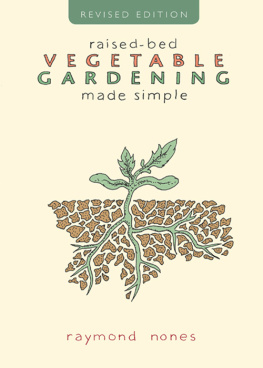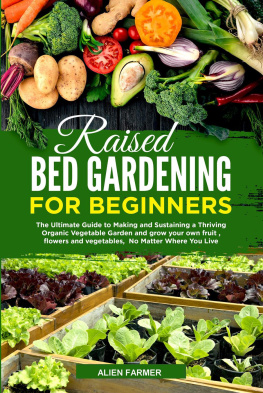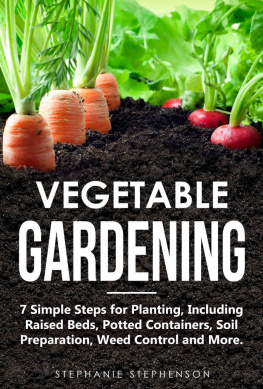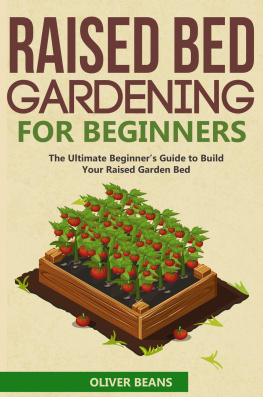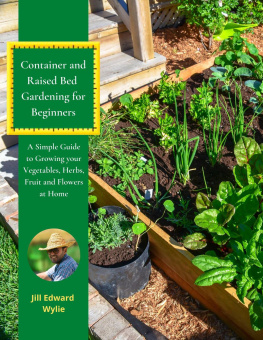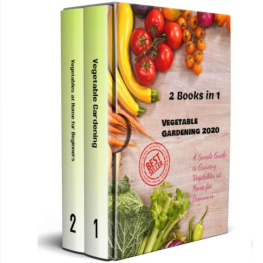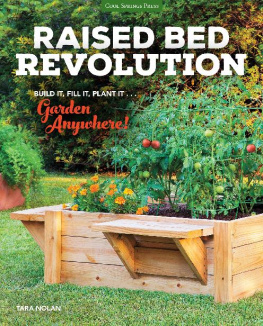
RAISED-BED VEGETABLE GARDENING MADE SIMPLE
The Three-Module Home Vegetable Garden
Second Edition
Text and illustrations Copyright 2010, 2013 by Raymond Nones
Portions of this book together with many of the illustrations
were previously published in the following manuals:
Modular Vegetable Gardening Copyright 2002 by Raymond Nones
Green Thumbs for Everyone Copyright 2007 by Raymond Nones
All rights reserved. The use of any part of this book, reproduced, transmitted in any form or by any means, electronic, mechanical, photocopying, recording or otherwise stored in a retrieval system without the prior written consent of the author is an infringement of the copyright law and is forbidden.

Please read this: The author and the publisher have done their best to give useful and accurate information. But be aware that there are many variables in gardening and many facts are subject to differing interpretations. All of the recommendations are made without guarantee. You have the final responsibility to check all material you read here as to suitability, or accuracy, before relying on it. Of necessity the author and the publisher disclaim any liability in connection with the use of the information in this book.

Published by The Countryman Press, P.O. Box 748, Woodstock, VT 05091
Distributed by W. W. Norton & Company, Inc., 500 Fifth Avenue, New York, NY 10110
Printed in the United States of America
Visit our website at www.countrymanpress.com
ISBN 978-1-581-57188-2
ISBN 978-1-581-57710-5 (e-book)
Printed in the United States by Versa Press, Peoria, Illinois
This book is dedicated to the memory of my father, the late Gian B. Nones
Preface
I was born and raised in a small village amid the hills and hollows of western Pennsylvania. Back then times were hard, jobs were few, money was scarce and everyone bought their groceries on credit from Tomlinsons, the only store in the community.
What were plentiful were vegetable gardens. One could be found in practically every backyard. They provided a vital portion of a familys food needs.
As did my fathers: He loved gardening and every season as he worked the garden, my brothers and I were there with him, doing what had to be done. And there was plenty that had to be done: Spading, cultivating, unending trips down to the creek refilling the watering can, and every evening, if there was any possibility of frost, placing a tin can over the newly planted tomato and pepper plants.
Then, little by little, as the plants grew, the grocery bills shrank. Tomatoes were eaten out of hand as snacks, lettuce was plucked just minutes before the salad was served and corn was picked only when the water in the pot began to boil.
When, after many years later, I had the opportunity to start a vegetable garden of my own those long-ago memories were my motivation.
This book attempts to reflect the purpose of all of those hard-times backyard gardens. That is: vegetable gardening, although it can be a source of great enjoyment, is in essence a serious matter, an important food source.
During World War II, for health and economic reasons, Americans were encouraged to establish what were called Victory Gardens to grow their own vegetables.
The public responded and it was estimated that those little gardens produced a remarkable 30 to 40 percent of the countrys food supply during that period.
That was a long time ago, but the rationale for such gardens is timeless and your backyard vegetable garden today can still contribute not only to your well-being but to the nations as well.
Introduction
Any piece of land that is growing weeds or grass can just as well be growing vegetables. There are only two requirements, the area (or areas) where the plants are to be grown must: 1) Receive at least 6 to 8 hours of sunshine a day. 2) Be free of tree roots.
If you have a plot that meets those conditions, you can enjoy the benefit of having a supply of vegetables right in your own backyard freeing you from being solely dependent on the supermarket. Homegrown vegetables cost less, are fresher, and taste better than store bought. Also, if organically grown, which is the method described in this book, will not have been exposed to harmful chemical fertilizers and toxic pesticides.
Vegetables go a long way to keeping you healthy as they are one of the very best sources of important vitamins and minerals. Plus, beyond your physical well-being, gardening will also keep you mentally healthy. Working outdoors close to nature, growing living things, gives a unique satisfaction.
Anyone with a parcel of land, regardless of size, should strongly consider devoting at least a part of it to vegetable gardening. The physical, economic, and psychological rewards that can be derived from this activity are just too compelling not to give it a try.
Gardens come in all shapes and sizes: How big or how small will depend on many factors. The three-module home vegetable garden was specifically developed to meet the needs of the average family and will fit into the average-size backyard. It can be maintained by one person and since it is intensively cropped can be more productive than a much larger plot. It is also versatile if a larger garden is wanted, additional modules can be added at any time without limit.
Once the area to be planted is selected, the next decision to be made is what to grow. In this book specific crops have been recommended. The types and varieties have been carefully selected for a wide range of reasons. They are proven performers which provide a continuous harvest from spring up into late fall. Even so, it is recognized that preferences vary and there may be vegetables included that are not liked. Feel free to substitute. But where you live also needs to be taken into consideration. A crop that grows easily in one climate may struggle in others. Whats more, there may be vegetables that cannot be grown in some areas. Pick the ones that are suited to your weather.
My garden is in Floral Park, NY, USDA zone 6. The spring first frost free date is May 15th, the fall earliest frost date is October 15th. If you are outside of my zone you will have to adjust planting dates and other factors so that they are right for your area. If you dont know your USDA zone, call your local or regional Cooperative Extension Office and they will tell you.
That aside, for first time gardeners, it is suggested that they plant as many of the selected vegetables as feasible to start. At the end of that initial season they will have gained significant insight as to what crops will be best for them to grow.
In addition to the personal benefits derived from growing your own crops, on another level, your garden will help in alleviating the food shortage that exists in many parts of the world. You may think that your little plot will not make much of a difference, but when multiplied by many, many similar backyard patches it all adds up to having a major impact. The commercially produced food that would have been consumed by home gardeners is now available to the starving.

